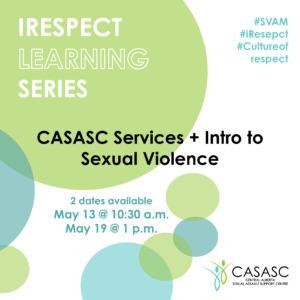The Education Team has a question from a parent regarding Internet use and an issue known as sextortion. Some of the topics in this question may be triggering or hard to read. Emotional safety is very important to the CASASC education team. We do feel the following question is important to answer. If you need any further support, you can reach out to our help line anytime at 1-866-956-1099.
Parent Question: Hi there, I have a question. My daughter is a teenager and is spending more time online. We as a family have talked about how to act and treat others online. I am not concerned about that. What I am concerned about is her getting in trouble with people asking for her images online. I remember the Amanda Todd case from years ago and I am worried that she may be tricked into a similar situation. How can I talk to my daughter about this, and make sure she is safe online?
CASASC Response:
The issue you are describing is sextortion. Sextortion is where someone (a peer or stranger) asks for a person’s nude images and then uses those images as blackmail in order to receive more images or money to stop the images from being leaked or sent out to loved ones. It is a rare, yet serious form of online violence that can happen to anyone regardless of gender. The Amanda Todd case you mentioned is a Canadian example of this issue and it unfortunately ended in her suicide.
Sextortion can happen with something as innocent as flirting or chatting online with a peer or stranger. Sometimes images are asked for outright or a person may be prompted to flash or expose themselves on a web camera. Then, the other person may take a screenshot from their computer or device, thus saving the image as blackmail material. This is known as “camming” and is what happened in Amanda’s case.
In Canada, under the Criminal Code, harassment, uttering threats and distributing images of someone who is under 18 is illegal and those found responsible can be charged. Sextortion involves blackmail and processing and/or distributing images of child pornography, both of which are illegal acts.
It is good to hear that you want to keep your daughter safe from being sextorted. Like cyberbullying or stalking, sextortion can have numerous mental, emotional and social consequences for the youth involved.
Online harassment can have detrimental effects that can last for a lifetime. Some effects include an increased risk of suicidal thoughts, self harm, loss of feeling safe, social anxiety, being isolated from friends and peers, etc. (1)
There are ways that you as the parent can help support and teach your daughter to avoid being put into a position where she could be sextorted. We have included the links to several websites as further resources.
You can teach your daughter to recognize the following warning signs when chatting with someone online as outlined by Cybertip.ca, a great resource for online safety.
Warning Signs:
1)Everything happens quickly
The other person either asks for images or videos outright, wants to speak on a web camera (through web functions like Zoom, Skype or Messenger) or starts asking for personal information that may be used against a youth later.
2)Chatting becomes sexual
This can be through jokes, innuendos, or regular chatting and flirting.
3)Attention Bombing
This essentially means making contact numerous times a day. This can be controlling behaviour masked as someone who is caring and attentive.
4)Using threats
This can be a way to make someone feel unsafe, embarrassed, or guilty, all in a way to make them comply with requests for images or to chat via web camera.
5)Provides inconsistent information
What they say vs. what they post, or share may be different. For example, a person online may say they are 15 years old, but the images they send appear to be of someone older. A person who uses sextortion against others may pretend they are younger, or pretend they are a different gender to receive images. For example, a man may pretend to be a younger girl to chat with boys online.
Red Flags:
If your child notices any of these red flags, it is important that they know they can come to you, or another trusted adult to talk about and report the issue. You as the parent must make sure you remain calm, open and listen to your daughter, so to not discourage her from coming to you with a future problem. Have her show you what is going on and try and document as much as you can. This includes any email addresses, online handles, usernames, location, contact information etc. Then, block this person and report to the police. Alberta RCMP have an Integrated Child Exploitation Unit (ICE) who investigate matters of online sexual exploitation in minors, including sextortion concerns.
If your daughter comes to you, and worries that she may have been a victim of sextortion, it is important to remember the following things:
1)Stay calm and do not panic
For both you and her. Your next steps are to document as much as you can and report it. This can be done through your local RCMP, or through CyberTip.ca, which does handle reporting of online harassment and sextortion.
2)Immediately stop all communication
This involves deactivation—not deleting—any accounts, and not logging in or checking to see if the person contacted you again. You can ask your daughter to show you how to deactivate an account, or the web platform’s help center may have more information.
3)Do not comply with any threats
This is important for any youth to know. They do not have to do anything they are uncomfortable with or feel may be harmful to them. If it makes them uncomfortable, they should log off and speak with a trusted adult.
Remember, it is never the youth’s fault, it is always the person’s fault for using threats and blackmail.
Additional Resources:
1) https://mediasmarts.ca/sites/default/files/guides/ywca-guide-for-trusted-adults.pdf
2) www.dontgetsextorted.ca





